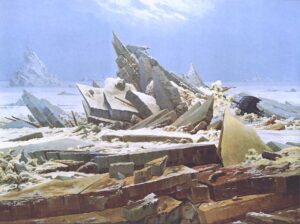
The removal of a Confederate statue in Virginia


The removal of a Confederate statue in Virginia

Caspar David Friedrich was one of the most prominent German painters during the Romantic Era. He was born on September 5, 1774, in Greifswald, Pomerania, which is now apart of Germany. He died May 7 1840 in Dresden, where he was a professor and artist for many years. He is known for his vast landscape paintings, invoking the mysterious and regal elements of nature. These would come to be understood as key elements of German Romanticism, and Friedrich was a defining artist of this time. He helped to define the sublime as a key part of the Romantic era, combining religious elements with nature. Human helplessness against nature was a central theme of his work, seen in the piece above.
Das Eismeer, further known by its English name The Sea of Ice, is estimated to have been painted by Friedrich in 1824. It depicts a frozen seascape, with a large pile of thick sheets of ice dominating the foreground. In the background, it is clear that the ice has damaged and sunk multiple ships. Wood hulls stick out from the ice spires amid a bright polar sky. It is believed that Friedrich was making a reference to Sir William Parry’s expedition to the Arctic in 1819. Fueled by a reverence and fear of the powerful forces of nature, Friedrich may have been making a commentary on his worries for venturing into the arctic. The expedition was largely successful, but The Sea of Ice depicts an alternate reality.
This painting captures not only the seascape of the arctic circle but provides a window into German Romantic feeling for nature. Certain land- and seascapes were held in high regard as spiritual, powerful places. The idea of the sublime in nature can be seen in many Caspar David Friedrich paintings, and may have helped to found the modern German feelings toward nature. Today, the idea of waldeinsamkeit is a uniquely German concept referring to the peace and serenity one feels in the forest. This term speaks to the feeling of clarity being in a sublime natural environment can imbue in people. Perhaps these types of associations with nature as both a peaceful place of reflection and an expanse of great power can be tied back to the Romantic painting of Caspar David Friedrich.
Sources:
https://www.bbc.com/travel/article/20210314-waldeinsamkeit-germanys-cherished-forest-tradition